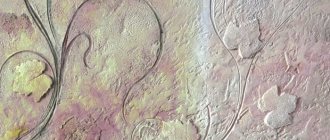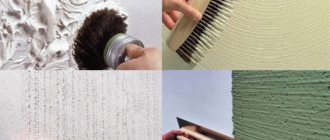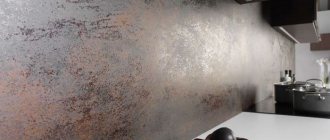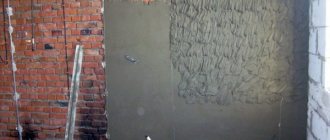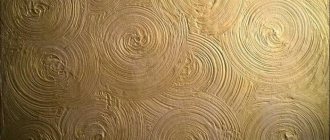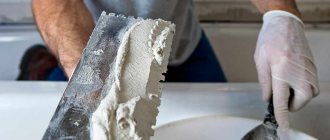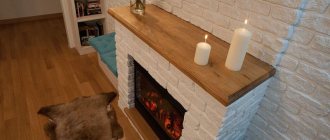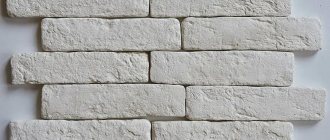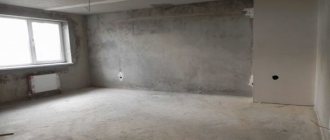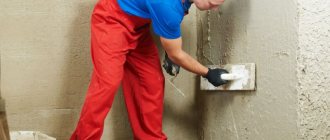What is textured plaster and what is it used for?
Textured plaster is a special type of finishing coating that creates a decorative relief on the surface of the walls. The depth of the relief of such finishing varies from 1 to 5-7 mm. It is created thanks to fillers of various sizes and shapes included in the plaster, as well as special application techniques.
Currently, textured finishes have gained immense popularity as a finishing coating for walls. It is popular not only for interior work, but also for exterior plastering of facades.
The material differs in structure, composition and color, which means it allows you to choose the most appropriate option for a textured pattern in each specific case.
The textured mixture helps create a unique interior without requiring any special effort. It is easy to work with the solution yourself; in most cases there is no need to involve professional workers.
Textured plaster is widely used for interior decoration
Textured plaster made of cement-sand or lime mixture
This is another cheap option that is best used for exterior work. The fact is that the resulting surface will be rough and cold, so it has no place in a living space.
To prepare decorative plaster you will need:
- cement;
- sand;
- water;
- liquid soap.
First, sand and cement are mixed in a 3:1 ratio, after which a little liquid soap is added to the mixture. At the end, pour in water and stir until it reaches the consistency of sour cream. Using a regular wide spatula, the mixture is applied to the prepared surface, after which it is decorated with a brush, trowel, shaped spatula or roller. The mixtures have rather poor adhesion, so the surface must be treated with a primer.
Textured plaster made of cement-sand mixture
To prepare the lime mixture, mix slaked lime and water in proportions of 1:3. The so-called lime paste is obtained, then this material is mixed with cement and sand in proportions 1:1:3 or 1:1:5. The application method is the same as with the previous material.
Advantages and disadvantages
Let's consider the positive qualities of the finishing material:
- textured coating looks good and contributes to better interior design;
- the surface relief can be designed in different styles, creating beautiful patterns by choosing a special technique for moving the tool;
- the material is durable, the surface retains its original appearance for a very long time;
- the mixtures are resistant to ultraviolet radiation, so they do not gradually fade in the sun, maintaining their original attractiveness;
- the finishing coating improves the thermal insulation qualities of the base;
- mixtures for interior decoration do not contain aggressive chemical components, therefore they are considered environmentally friendly for people;
- The color of the finish can be changed as desired by adding dyes to the solution.
On a note!
The finished mixture can be supplemented with other components to create original visual effects.
The disadvantages include:
- the coating does not withstand strong impacts, gets scratched, chips;
- a textured surface is more difficult to clean from dust;
- for high-quality materials you will have to pay an impressive amount;
- in order for the surface to look holistic, the mixture is applied without delay or interruption;
- surface defects are very difficult to correct.
If the application technology is violated, cracks may appear on the surface. The material often peels off and swells. Therefore, you need to choose a mixture suitable for the specific type of base and follow the manufacturers’ recommendations when performing finishing work.
Modern types of plaster
More and more new types of interior surface finishing are presented by modern manufacturers. These include:
- colored plaster, based on acrylic and marble chips - it is characterized by water-repellent properties and hardness. The variety of colors is represented by more than fifteen shades - the solution is applied to a dry, clean surface in one layer. The solution can be applied to the outer and inner surfaces with equal success, but in order to prevent the formation of joints that will be noticeable, the plastering process should be carried out from corner to opposite corner.
- Roller plaster is characterized by an organic filler of various sizes - when applied, channels are formed that are located in different directions. Decorative patterns are formed by applying the mortar to the wall with a wide spatula, and then rubbing it with arbitrary movements in a circular and horizontal motion. With roller plaster, the color is often added to the dry mixture, or painted after the solution has hardened.
- latex plastic so convincingly imitates the structure of polished stone, its gloss and shine that you can make a mistake in determining the surface texture even by touching it. The finished plaster resists cracking and repels water, making walls easier to clean. And colors that are similar in tone are ground in the solution, without over-stirring - then the structure of the stone is formed, imitating relief structures. Before applying the plaster, the walls are puttied and treated with a deep penetration primer.
- The wet silk relief convincingly imitates this precious fabric on the walls - mother-of-pearl particles in the dry mixture demonstrate the shimmer of silk and all its color possibilities. This plaster is produced in a few, but extremely spectacular colors - the coating is available in white and golden colors, has the color of ripe garnet and metallic silver and bronze shades. This coating is moisture resistant, which allows it to be washed and cleaned; therefore, this type of plaster is most often used for the kitchen.
- The sea breeze technique allows you to apply translucent colors with a slight pearlescent tint to the walls. This effect is achieved by the fact that the plaster contains fine-grained river sand - the play of colors in such plaster is achieved by randomly applying the solution, followed by thoroughly rubbing it on the wall. The main colors when using this technique are golden, white and garnet tones; among the metallic colors, bronze is used, but the most spectacular is the chameleon shade, which can change colors depending on the lighting. The use of plaster using the sea breeze technique is most often used in interior design.
Types of textured plaster
Finishing walls with textured plaster allows you to achieve different visual effects. The desired pattern or pattern can be achieved using additional components or filler in the texture mixture. The method of application also plays a significant role. Next, let's talk about the most popular effects of textured plaster (types of textures).
The market range of textured plaster is quite wide
Bark beetle
Rolling solution is also known as "Bark Beetle". The appearance of the coating resembles “eaten wood”. The solution contains marble chips measuring 0.1 - 4 mm. A pattern with a uniform texture is made with a plastic grater, grinding the surface with chaotic movements. Thanks to the grater, the marble grains roll, leaving grooves behind them, and the semblance of woodworm “passages” are formed.
To achieve this effect, a material thickness of 3-7 mm is required. It is used for finishing both outside and indoors.
You can get other patterns from the roller mixture by changing the direction of grouting: the “Lamb” pattern (circular movements with a grater), “Rain” (vertical movements), “Carpet” (horizontal movements).
Bark beetle plaster is riddled with numerous passages
Making decorative plaster from putty
All of the above materials are quite convenient to use, but they have one common drawback - high cost. Decorative plaster made from ordinary putty will cost much less.
If you want to save money, the decorative surface can be made from ordinary putty
To carry out this operation you will need the following:
- putty (manufacturer is not important);
- Venetian relief spatula (you can also use a trowel, but in this case the design will not be so original);
- regular spatula;
- sandpaper.
First of all, apply the putty in an even layer over the entire wall, after which the surface is treated with a Venetian spatula using random movements and left to dry. After 3-4 hours, using a regular narrow spatula, remove fragments that stick out too much, and the entire surface is cleaned with fine-grain sandpaper. Finally, the surface is treated with primer, paint and varnish, as is the case with ready-made plasters. This method allows you to save money, but the result will be the same.
Video: DIY textured plaster master class
Classification by type of base
Depending on the type of base included in the composition of textured plaster, the following varieties are distinguished.
Mineral
The composition of such plaster includes a cement mixture, as well as additives that increase the plasticity of the composition. Mineral plaster is most often applied to an already prepared surface coated with a quartz primer. The mixture is white, but thanks to pigments it can have any shade. Produced by Ceresit, Kreisel, Bolars, Vetonit.
Silicate
Made of silicate glass. A feature of silicate plaster is its rapid hardening and the need to quickly create the desired pattern. Silicate plaster has high vapor permeability and resistance to external influences. That is why it is most often used for facade work. Produced by Ceresit, Caparol.
Compound
Usually, mica, gypsum, sand, ground brick particles, and wood fibers are added as inclusions to plaster mixtures.
Textured acrylic plasters also contain acrylic resins. This allows you to give the mixture the necessary plasticity and increases the possibility of setting with bases of all types.
The use of a spectrum of acrylic paints makes acrylic-based plasters the leaders. This finish is durable and durable. But there are also disadvantages. First of all, the flammability of the mixture and the ability to attract dust.
Classification according to other parameters
There are a large number of types of textured plaster. The special components included in the composition allow you to create different visual effects. For ease of use, the plaster is sold ready-made or as a dry mixture. Decorative finishing of surfaces is carried out under various conditions. Therefore, the requirements for plaster mixtures are also changing.
According to delivery form
The material is sold as a ready-made mixture in buckets or in paper bags with a powdery substance. Dry solutions are mixed with water and dyes. The average weight of the bags is 25-30 kg.
Ready-mixes are often colored during production and do not require the addition of any components before finishing. The solution is applied to the base without difficulty, since the number of components in it is perfectly balanced.
It is better to use the finished material when finishing small areas, but the limited choice of colors often forces you to choose a dry mixture.
By application
The composition of plaster mixtures differs because interior finishing requires skillful execution. Necessary properties for indoor work:
- ease of application;
- good decorative properties;
- vapor permeability;
- ease of cleaning.
The bathroom walls and ceiling should have a waterproof coating. In the bedroom and living room, the plaster should allow oxygen to pass through well. The covering of kitchen walls should not absorb odors. Staircase openings require the strongest cladding that can withstand impacts.
According to operating conditions
Textured mixtures are used for interior and exterior decoration of buildings. The requirements for building mixtures differ in different places. Therefore, decorative plasters are divided into:
- façade;
- materials for interior work;
- universal.
The mixtures differ in composition. To create facade finishing, toxic or less safe components are used. The special composition increases the resistance of the coating to external influences. The finishing coating is used in extreme conditions.
Mixtures for interior decoration are often more expensive, since substances that are harmless to humans are added to them to maintain good performance. These components are more difficult to manufacture and therefore cost more.
Manufacturers offer all textured mixtures in the form of a ready-made solution or powder
By gloss level
There are different types of textured mixture for walls, depending on the degree of gloss:
- Matte. The color of the coating does not change tone depending on the direction of view; the surface will be the same from any angle.
- Glossy. The coating of such plaster “shimmers” in the light. As a rule, reflections of a glossy surface affect the perception of tone, which must be taken into account when selecting a color tone.
- Intermediate. This textured plaster has average gloss values between matte and glossy plaster. The effect of tone depending on angle is less pronounced.
Important!
When tinting glossy plaster, professionals recommend choosing a color several shades lighter, because... The glossy finish makes the color darker.
Existing types
There are different types of plaster (popular types of decorative plaster). Among the textured plaster presented on the shelves of construction stores, you can find options with different binding components. Depending on the type of base ingredient, it can be:
- mineral;
- acrylic;
- silicone;
- silicate.
Mineral
- available for sale in dry form;
- simple solution preparation;
- has a cement base.
Affordable in terms of cost, but by no means a ready-made option. After purchasing the package, you need to prepare a thick and viscous solution. It is best to do this with a mixer - this way the plaster will be completely mixed with water and will be better applied to the surface. True, you need to paint it in the desired color after applying it to the wall - it will not be possible to dissolve the necessary paint in a container.
Acrylic
- based on acrylic resin;
- very plastic, has standard water resistance;
- slightly flammable.
A textured plaster that is very convenient to apply to the wall and holds any shape perfectly. The main thing is to carefully work on the base surface, level it as much as possible and prime it. Like mineral, it is also sold in dry form.
Silicone
- durable;
- suitable for any capital surface;
- demonstrates excellent adhesion;
- high price.
Yes, you have to pay for convenience. This textured plaster is perfect for any walls; it is sold in an already prepared form and, most importantly, with dye already added. All that remains for you is to simply apply it to the surface. The high cost still
scares off many, but the result of application cannot but rejoice. Take a look at the photo where silicone-based textured plaster shows itself in all its glory.
Silicate
- based on potassium glass;
- used primarily for external work.
You definitely won’t need this type if the focus of your work is solely on interior decoration. Save it in case you need to do any façade work in the future.
Textured plaster is also distinguished by the type of grains:
- finely textured - less than half a millimeter
- finely textured - up to 1 millimeter;
- medium textured - up to 2.5 millimeters;
- coarse textured - up to 5 millimeters.
The size of the grains
is of great importance, as it allows us to achieve the necessary decorative effect in each individual case.
Color range of textured plasters
More often, paints that imitate natural materials and wood textures of different shades are used. White is used in office spaces or public reception areas. This type of finish can be used in small bedrooms.
A room with white walls will appear brighter, cleaner and fresher. This color serves as the basis for a variety of color additions.
On a note!
Gray shades are suitable for modern style, for finishing under concrete. Pearlescent colors give each room an oriental flavor.
Plaster consumption
The thickness of the layer and the features of the textured pattern determine the consumption of the plaster mixture per 1 square meter. m. Packages of plaster indicate the average weight consumed per 1 square meter. m.
What is the cost:
- The bark beetle is applied in a layer of 2 mm, so per 1 sq. m. you will have to spend 2.7-3 kg. This means that 1 bucket of 25 kg covers 8.5-9 square meters. m.
- Relief treatment with a 3 mm layer of gypsum mixture will require 2.5-3 kg per 1 square meter. m.
- The cement mixture for textured finishing consumes 5-5.5 kg per 1 square meter. m. with a thickness of 3 mm.
Important!
For the most accurate calculation of consumption, you need to lay the plaster on the wall in an even layer. During the work process, it is more convenient to make calculations in the number of buckets per 1 square meter. m.
Before buying a tool for decorative plaster, you need to decide on its type
Techniques for applying decorative plaster to walls
The quality of a decorative coating directly depends on the condition of the tools used to produce it. All of them must be free of coating defects and free from cracks or nicks.
Types of applying decorative plaster differ in their own technique to give walls special expressiveness and new artistic properties.
To apply Venetian plaster, which requires a special multi-layer design, the work is carried out with spatulas made of stainless material of various sizes. The base of the plaster layer is applied with the widest spatula, and the gaps should not only remain, but also become an important component in the compositional design.
The initial layer is made wide and completely devoid of symmetry.
All layers that are applied to the base should cover the faded layer with a brighter color, and vice versa, try to press the bright layer more so that it becomes less expressive. To achieve color shifts, each layer can have its own shade that is similar in color. Each layer is dried, leveled and sanded; an ironing process is carried out to give a glossy surface. And, for additional shine, the finished layers of plaster are coated with varnish or special wax. The transparency of each layer gives the wall surface an effect of volume and depth.
Plastering decorative types of textures with a relief pattern is carried out somewhat differently - it does not require special processing or leveling of the walls. It is enough just to remove old layers, wash and dry the walls. In the next step, the wall surface is treated with a primer, which has deep penetration properties and an antibacterial composition, which prevents the appearance of fungus and mold. Prime the wall covering a day before the start of plastering work and make sure that the primer layer is completely dry.
The plaster solution is applied to the wall surface with a wide spatula with a soft surface, then a relief is quickly made over the wet plaster. To obtain different textured surfaces, tools such as spatulas of various shapes, rollers, sponges and various stencils are used. The formation of relief is carried out immediately from one wall to another in order to achieve a uniform surface without visible seams.
Decorative plaster types and methods of application are carried out using special knowledge - in order to apply structural plaster with high quality, you need to remember that the main plastering tool is a trowel made of stainless steel. The layer of plaster should not be much larger than the size of the composite grains, and after application the layer of plaster is left to set for 2-3 minutes. After that, smooth the layer of plaster in a circular motion with a plastic trowel. In this way, a uniform distribution of the granules that are in the solution is ensured, and the excess mass is removed from the trowel with a smaller spatula. To ensure that the joints are not visible, they plaster and make a relief surface, working quickly from corner to other corner. If the coloring layer was not added to the dry mixture, then painting is carried out no earlier than 10-14 days after plastering.
How to make textured plaster yourself
You can make textured plaster for walls with your own hands. Materials available in the market are used to make a suitable mixture.
With PVA glue
Regular putty is mixed with PVA or wood glue or drywall putty.
With primer
The main component is a fine-grained white mixture. A primer is added to it in a ratio of 6:2. The consistency of the mixture should resemble thick sour cream. Color pigment is added to create a tint.
With plaster
Gypsum plaster is mixed with wood glue or PVA and left for 5-10 minutes. Then it is mixed again and applied to the wall.
With baby
If you add marble chips to the putty, you can imitate natural stone. You need to stir the ingredients with water until the mixture becomes thick, like sour cream. Color pigments are not added to the solution, so the plaster can be painted only after it has dried.
Structure and fillers of plaster
Through the use of special tools and the use of various additives, the type of coating changes. In the photo of textured plaster you can see the structure and relief that fillers form.
The more common mineral fillers are marble, granite and quartz chips.
Many manufacturers use polymer granules, cellulose and silk fibers as additives. Each filler is individual and gives an interesting effect.
If you are new to applying plaster, then the manufacturer does not advise you to immediately take on large amounts of work.
Textured plaster for walls is a very interesting material to work with, but it is advisable to take training courses first. You can achieve various types of textures using stencils, textured rollers, and trowels.
How to apply textured plaster
There are many ways to apply textured plaster. To create an original relief, various tools are used, and special techniques for applying the mixture are mastered. The textured surface is created by imprinting, brush strokes, trimming, and various stencils. A relief on the wall can be created using the modeling technique.
Roller
Let's figure out how to apply textured plaster with a roller. You can use different types of this tool:
- rubber embossed with patterns that leave imprints on fresh plaster;
- rollers for loosening the mixture on the wall and creating a fur coat effect.
Note!
The roller can be rolled over fresh plaster 10-15 minutes after application. To prevent excess mixture from sticking to the roller, you need to moisten it with water.
Stamps, stencils
To imitate wood texture or masonry, stencils or stamps made of elastic and rigid materials are used. The surface of the tool is moistened before contact with fresh plaster. The stamp is pressed into the surface so that a print remains on the wall without defects.
Stencils are used differently. You can use them to create three-dimensional patterns or designs, the thickness of which does not extend beyond the boundaries of the general layer. The stencil is attached to the wall, then decorative plaster is applied on top. The surface is visually modified with other tools and materials. Then the stencil is carefully removed. Such tools allow you to create patterns on the wall from plasters of different colors.
Trowel
The trowel allows you to give the surface a varied texture and smooth out sharp ridges left after the roller. You can move along the surface only with the corners or the entire plane of the trowel horizontally, vertically, or make circular movements. It all depends on what exactly the pattern should be.
Venetian style - two-color application technique
The technology for applying Venetian plaster only seems complicated.
Let's look at a simple instruction:
- plaster the wall, prime it;
- After complete drying, apply a thin layer of tint;
- after 6-8 hours, prepare a light and dark mixture;
- the components are applied to the trowel, then arc-shaped strokes are made on the wall;
- the first strokes should be at a distance, then you need to close the empty area between them;
- then you can mix 2 different colors with a trowel and fill all the empty spaces with the mixture to completely cover the wall and imitate a marble surface;
- after the plaster has dried, the surface is rubbed with a spatula or sandpaper, and protruding pieces of the mixture are removed;
The surface is then varnished or waxed.
The stencil allows you to create complex patterns even without experience
Versailles reception
First, the wall is treated with a quartz-primer mixture several times. Then the model composition with a thickness of 2-3 mm is applied with a trowel. The mixture is worked with a plastic trowel to create an arched pattern. You need to make short passes with the tool, constantly changing the direction of its movement.
The trowel is lightly pressed against the surface and pulled upward in an arched manner. The result should be sinuous indentations. Wall cladding in the Versailles style is made from ordinary putty.
If the layer is too thick, you need to wait until it dries completely. This often takes several days. After drying, sharp protrusions and protruding mixture are removed. The surface is dust-free and primed. Then the coating is painted with a mixture of tinted primer and silver. For this work, a hard foam roller is used. In this case, the color of the recesses does not change. Then the entire surface is covered with a mixture of varnish, glitter and plain water.
Using improvised means
The textured surface is created using various available means:
- chopped fragments of foam rubber;
- pieces of fabric gathered together;
- crumpled polyethylene;
- cutlery;
- combs.
An original pattern can be created with any object. The main task is to show imagination.
Applying textured plaster with your own hands
The work consists of 4 stages:
Preparatory. Leveling the surface with a primer and using various types of auxiliary products (antifungal compounds, etc.). If you need putty, apply it in several layers.
Base. Preparing plaster for use (be sure to read the instructions). Apply the composition over the entire wall with a wide spatula. Smoothing the plaster using a trowel to a thickness of 3 mm. Working with corners with a narrow putty knife.
Creation of invoice; Most often, a roller, trowel or stencil is used. If you use a hair roller, you can immediately create a surface with a pattern. The stamp must be periodically cleaned and moistened with water. When using a trowel, you cannot apply the texture to the depth of the base.
Final. Drying the wall. Afterwards a layer of primer is applied, then the painting stage begins.
Decoration
After drying, the finished surface is covered with wax, varnish or paint. These materials give the plaster strength. The treated surface is easier to care for. For decorative plaster, special varnish and paint are used. Their components are compatible with the materials from which the mixture is made. To reduce varnish consumption, you can pre-prime the wall.
One of the original types of ceiling finishing is decorative plaster.
Painting plastered relief walls
A textured surface makes painting more difficult; a textured wall requires more finishing coat. When applying, you need to ensure that the paint gets into even the smallest crack. For this, in addition to a roller, you can use thin brushes, sponges or a spray. To prevent drips from appearing, excess paint must be smeared. The 2nd layer is applied to visually separate the convex parts of the surface.
Advice!
The paint can be tinted before use. Experts recommend adding a little black to the color to make the painted surface look natural and less irritating to the eyes.
Bas-reliefs
The surface is decorated with bas-reliefs using the method of self-sculpting or fixing ready-made plaster products. For manual work we use:
- spatulas;
- rollers;
- chisels;
- various tools for woodworking.
Fine-grained plaster or gypsum mixtures are used to make bas-reliefs. They are quite elastic, retain their shape and are easy to sand. Before applying bas-reliefs, the base cannot be pre-primed or varnished, so as not to deteriorate the connection with the surface. For modeling, you can use special templates. With their help, it is easier to leave patterns on horizontal and vertical stripes.
Differences in decorative plasters by composition
The performance properties of plaster are largely determined by the type of binder, which is responsible for transforming the solution into a solid monolith, the degree of adhesion of the applied decorative layer to a particular base and its ability to maintain the shape given by the master. On the building materials market you can find four main options for the component composition of such mixtures.
Mineral
Mineral-type plaster is made from sand and cement, to which modifying additives are sometimes added. Due to the availability of the components used, it is sold very inexpensively. It is supplied in the form of dry mixtures stored in sealed packaging. A working solution from it is prepared immediately before use, mixing with water according to the proportion recommended by the manufacturer.
Mineral decorative plaster.
The layer applied to the wall after drying is characterized by high strength, resistance to temperature changes, and the ability to pass vapors and gases through it.
Acrylic
Acrylic plaster is distributed in a ready-to-use state. It contains crushed mineral fillers, acrylic resins and special additives that give the mixture special performance properties.
Acrylic decorative plaster.
This solution fits well on most structural materials used in construction. Due to its high elasticity, it does not shrink and cracks appear after hardening. Walls covered with it almost do not absorb water and do not allow vapor to pass through them. Initially tinted compositions do not require subsequent external painting.
Silicate
Silicate plaster is a mixture of fine mineral fillers with polymer resins and liquid glass, which is an aqueous solution of alkali metal silicates.
Silicate decorative plaster.
It is sold ready for application, packaged in plastic jars or buckets. It is convenient to use due to its increased plasticity. In its frozen state, it has high strength and good vapor permeability, allowing rooms renovated with its help to “breathe.”
Silicone
Silicone plaster mixtures contain binder polymer resins based on organosilicon high-molecular compounds. They are sold ready to use. Due to the complex production technology of the main components, the price of the material is quite high.
Silicone decorative plaster.
The coating obtained on this basis is elastic and therefore does not produce visible defects when drying. It allows water vapor to pass through, but prevents the absorption of moisture and, due to its electrostatic properties, repels dust settling on its surface.
Popular manufacturers
In Russia, the most popular manufacturers are:
- Cerezit;
- LPINA;
- San Marco;
- VGT;
- Bolars;
- Optimist;
- Bilix;
- Bayramix.
Fact!
German, Italian and Polish brands are the most popular.
Today there are many manufacturers of decorative plaster on the market.
Repair of texture defects
Plaster with a relief surface is difficult to restore. It’s easy to reproduce the texture so that it blends with the wall. However, choosing the right color is almost impossible. The outdated coating gradually fades in the sun, and the new paint will still stand out against the general background. Therefore, you have to paint the entire wall.
The peeled areas are determined with a rubber mallet. The loose plaster is completely removed, the exposed area is dust-free, primed and restored.
What to choose – liquid wallpaper or textured plaster
Working with liquid wallpaper is easier and faster. However, decorative plaster is reliable. The textured mixture is applied to the inner surface of the walls and to the facades. It withstands moisture and sudden temperature changes.
Liquid wallpaper does not add strength to walls and is used only to create a visual effect. This material cannot be applied to ceilings and other horizontal surfaces. However, liquid wallpaper is presented in a wider range. You can choose the appropriate coating from a variety of colors and textures.
Peculiarities
Textured plaster has become so widespread due to its many advantages in use, such as:
- Versatility. Used for both interior and exterior work. Apply to wood, concrete, brick, metal and some other surfaces. Textured plaster is also used to finish the ceiling.
- Sustainability. She is not afraid of frost and moisture. Also has soundproofing properties.
- Environmentally friendly. Consists of natural ingredients. Does not absorb harmful substances from the environment.
- Durability. If the plaster is applied correctly, you will get an excellent coating that is resistant to mechanical stress.
- Masking. Perfectly levels walls and hides cracks.
Tips and tricks from experts
Experts give tips to make your work easier:
- when decorating spacious rooms, it is better to save on purchasing a powder mixture;
- the purpose of the finished mixture is always indicated on the packaging; you cannot ignore the manufacturer’s recommendations and use the plaster in the wrong places;
- to choose the mixture correctly, you need to study the features of its application and the conditions of upcoming operation;
- material is taken with reserve, since sometimes it is necessary to redo defective areas.
By following simple recommendations you can create a truly unique interior.
Leading manufacturers produce various styles of textured plasters. Some types for interior decoration are also suitable for exterior use. Exterior plaster is often used indoors if it has a low toxicity rating.
Was this information useful to you? Share in the comments!
Price
The cost of the decorative composition depends on the brand of the incoming components. Buying ready-made textured plaster from well-known manufacturers can be expensive. The price for 1 m2 of treated surface depends on the professionalism of the specialist, the quality and speed of work. If you do everything yourself, then renovations in a house or apartment can be done without spending a lot of money and time.
But you can also buy a ready-made mixture. VGT textured plaster is easy to apply. It is highly viscous and coarsely dispersed. It is distinguished by its versatility, as it can be used to decorate various coatings. In addition to elasticity, the composition is moisture resistant. Suitable for indoor and outdoor use. Preliminary preparation of surfaces is not necessary. All defects are smoothed out using this mixture, which is made on the basis of acrylic binders and marble chips. One container holds 18 kg. 2 kg of mixture is required per 1 m2 (when applied in one layer). This means that one container is enough to treat a wall with an area of 9 m2.
Subscribe
